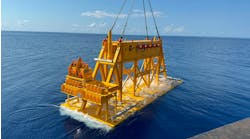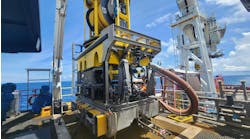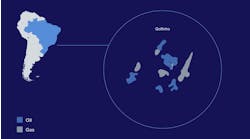PLATFORM/FIELD DECOMMISSIONING: Part II: State-of-the-art of removing large platforms located in deepwater
PART II: This is Part II of a two-part series on removing or partially removing large platforms located in deepwater.
The load weights associated with deep-water platform installations and removals limit the number of existing heavy lift vessels (HLVs) that can be used in these operations. The US Minerals Manage-ment Service (MMS) reviewed conventional HLVs that can be used to decommission deepwater platforms like Hidalgo, Gail, and Harmony, all located offshore southern Cali-fornia. Also included are evaluations of alter-native HLVs currently being developed with an assessment of the potential to apply them to the removal of deepwater platforms.
A limited selection of HLVs working around the world today can perform the tasks required for removing deepwater platforms. HLVs selected should have the capacity to lift the largest module and jacket sections. The heaviest module lift for the Hidalgo and Gail platform removals is on the Gail platform - 1,790 tons (dry lift weight). The heaviest module on the Harmony platform weighs 1,320 tons (dry lift weight). Additionally, if the jacket is to be removed in as large of a piece as possible, the resulting jacket sections will weigh more than the heaviest module.
Any HLV considered will need to be modified to meet local air emission requirements. Potentially, this could be very costly in that a catalytic converter may have to be adapted to each engine above 5 hp. Dynamically positioned vessels (DPVs) will most likely require more retrofitting than anchored vessels. These additional costs for DPVs could discourage their use.
Alternative HL methods
The following offers a summarized review of alternative heavy-lift technologies currently being developed for offshore platform installations and removals:
- Versatruss is a balanced, symmetrical, underside lift concept that makes use of a truss formation to lift a heavy load. In application, this system employs three readily available components: (1) standard cargo barges, which provide the lifting platforms; (2) steel A frames, which provide the structural support; (3) hydraulic winches, which supply the lifting force.
- The GM heavy lift vessel (GMHL), developed by ProSafe and the engineering company Global Maritime Heavy Industries (GMHI), uses existing, proven technology in a new way. The design uses an existing semisubmersible with a U-shaped extension that can remove a platform's topsides in a single lift. The extension is lowered below the bottom of the topsides by deballasting, positioned under the topsides, and raised to a point where the topsides can be secured to the U-shaped extension. Once secured, the topsides are lifted off of the jacket and can then be moved to shore or set onto a cargo barge.
- The Pieter Schelte, designed by Excalibur Engineering, BV, is a platform removal and installation vessel formed by joining two large tankers to form a stable platform. Topsides and jackets can be removed in discrete single lifts and transported to shore or to another location.
- The Marine Shuttle, designed by Marine Shuttle Operations, Inc. (MSO), is a steel hull U-shaped vessel designed for the transportation, installation, and removal of large offshore structures weighing up to 22,000 tons (using the ballast system). The structure comprises sections of tubulars 10 meters in diameter, tied directly to ballast tanks and ballast pumps. Water is pumped in during ballast operations and dumped for deballasting. This structure is unmanned and is not self-powered.
- The MPU Heavy Lifter, built by MPU Enterprise, is a U-shaped concrete hull unit with four columns and two hydraulic-operated truss-type steel lifting frames, with a large underwater body and a small water plane area. The MPU has no propulsion system; therefore, it needs to be towed by tugboats. Travel speed is approximately 3-4 knots.
- John Gibson Projects Ltd. (JGP) offers a range of standard strand jacks that can extend the lifting/lowering capacity of one or all of the alternative HLVs cited previously to 300 meters and beyond. This technology has proven extremely effective in tension-bridge construction projects, and is now being applied to offshore platform installations and removals.
- Type of buoyancy device (1): Buoyancy bags, manufactured by companies like Seaflex Ltd., are inflatable subsea buoyancy systems that can be attached to jacket members, conductors, or pipelines. Once attached and inflated, these units can lift sections (or, in the case of jackets, potentially the entire structure) to the surface. The bags are offered in either open-bottom or fully enclosed configurations. These units can be connected to piles or conductors by using divers or remotely operated vehicles (ROVs).
- Type of buoyancy device (2): The controlled variable buoyancy system (CVBS) is a patented concept being developed to provide an innovative and cost-effective means of offshore structure removal. It does this by providing buoyancy that is attached to strategic points on the structure. The magnitude of buoyant lift can be closely controlled throughout all stages of the removal operation. The CVBS consists of groups of buoyancy chambers, clamps, inflatable air bags, pipework, valves, and a sophisticated control system. A group of chambers equipped with clamps, local controls, and piping systems is referred to as an intelligent buoyancy unit (IBU).
Many of the alternative heavy-lift technologies reviewed may someday prove to be safer, more cost-effective ways to remove topsides and jackets. The designed load capacities for many of these systems are more than adequate for the topsides associated with deepwater platforms. However, deepwater jacket removal tends to be problematic for all alternatives reviewed.
Severing technology
For any cutting technique to be effective, it must be safe, reliable, repeatable, flexible and adaptable under field conditions, environmentally sensitive, and economical. The cutting techniques considered are grouped into two general categories: explosive and non-explosive.
Available explosive methods are bulk charges, configured bulk charges, and shaped charges. Current non-explosive methods applicable include diamond wire, mechanical cutters, and abrasive slurry cutters.
Explosive methods
Explosives are widely used to decommission platforms because they are safe, reliable, and cost effective. The use of explosives reduces the amount of time divers are used during the cutting process, thereby minimizing human risk. Their reliability has been established by the fact that they have been successfully employed to remove over 930 platforms in the Gulf of Mexico to date.
Additionally, the cost of severing piles and conductors is generally less than 1% of the total platform removal cost. Time is the driving cost factor when discussing severance. Delays in vessel spreads are the primary reason for cost overruns. A failure in the complete severance of a pile or conductor is usually charged to the owner of the platform. These costs can be enormous, as time and material rates for large crane vessels can exceed US$500,000/day.
Non-explosive methods
Non-explosive methods presently used consist of diamond wire, abrasive slurry cutters, mechanical cutters, and oxy-arc torch (diver cutting).
- The diamond wire cutting system (DWCS) is an external cutting tool that can be used to cut jacket legs, piles, and diagonal members above the waterline and underwater. Divers or an ROV can install the DWCS. Developments currently underway promise to overcome any limitations in the DWCSs present design. A sub-bottom cutter (SBC) is currently in development, which will facilitate cuts below the mudline. Additionally, a computerized cutting control system promises to provide faster cuts that are more successful in the near future.
- Abrasive cutting employs mechanisms that inject cutting materials into a water jet and abrasively wear away steel. There are two types presently in use: high-volume, low-pressure and low-volume, high-pressure. The first type of abrasive cutter disperses high volumes of sand or slag mixed with water volume (80-100 gal/min) at relatively low pressure (4,000-10,000 psi). The second type of abrasive jet cutters use low volumes of garnet or other abrasive materials injected at the nozzle at relatively high water pressure (50,000-70,000 psi).
- Mechanical cutting employs hydraulically actuated, carbide-tipped tungsten blades to mill through tubular structures. This method has been used most successfully on small-diameter caissons with individual wells and shallow water well-protector platforms with vertical piles. Limitations for the mechanical cutter include uneven cutting (from lateral movement of uncemented strings), replacement of worn blades, larger lifting equipment necessary to set the system, and more time required to make each cut.
Explosives are predictable, flexible, and reliable. Current industry practice uses explosives to sever piles below the mudline at any water depth. Until other techniques provide the reliability and effectiveness of explosives, these methods will continue to be used for pile severing.
Subsea technology
Due to the extreme water depths, several new subsea technologies were reviewed to provide alternative methods for assisting in pile severing and jacket cutting. These include advanced ROVs, hard-shelled diving suits, and directly operated vehicles (single-person submarines). These devices would be employed to perform a variety of tasks at deeper water depths, including:
- Valve operation
- Cutting steel and fiber cables or ropes
- Operating disc grinders
- Attaching external cutting tools
- Hot tapping
- High-pressure water jetting
- Removing of cuttings from wellheads
- Making and breaking hydraulic connections
- Bathymetric surveys
- Trench profiles
- Sub-bottom pipe tracking
- Video observation and still photography
- Tool-skid carrying capabilities.
ROVs are proven tools for safely operating in marine environments. The increasing need to use these machines at deeper and deeper water depths is driving the development of advanced ROVs that can be utilized in deepwater platform installation and removal.
In order to safely deploy divers at water depths exceeding 400 ft, diving suits used must meet the challenges of handling deepwater pressures while allowing divers to efficiently perform work in the deepwater environment.
As an alternative to ROVs or deploying divers in deepwater using hard-shelled diving suits, diving vessels (manned single-person controlled submarines) are currently being developed for deepwater operations. Also called directly operated vehicles (DOVs), these one-person submarines may someday prove to be extremely useful in deepwater decommissioning operations.
ROVs have been used successfully in a number of offshore operations for many years. Larger ROVs can provide the same key advantage of their shallow-water predecessors - decreasing the risk to human life. They can be fitted with a variety of cutting tools, assisting in external cuts at depths that are inaccessible to divers using conventional diving gear.
Conclusions
While a number of new technologies are currently being developed for the removal of offshore platforms, conventional removal technologies remain the best option for decommissioning deepwater platforms. Existing heavy lift vessels such as the Thialf, Saipem 7000, Hermod, Balder, and DB50 are currently the most cost-effective and dependable topsides and jacket removal systems available. Additionally, explosives remain the safest, most dependable, and reliable severing technique available today.
Of the three removal techniques reviewed, partial removal was rated the highest in the majority of evaluation categories reviewed. The partial removal scenario, combined with conventional heavy lift vessels, severing, and subsea technologies, is currently the safest, most cost-effective way to decommission offshore platforms located in deep water.
In that a number of the new technologies reviewed are close to becoming viable, an ongoing assessment of these technologies is required to remain abreast of the deepwater decommissioning state-of-the-art in the future.
Acknowledgement
The US Department of Interior's Minerals Management Service supported the development of this study - Sharon Buffington as technical leader and Jon Smith and Glen Shackell of the Pacific Outer Continental Shelf Regional Office. TEC-Demex provided the explosives data and report.
Editor's Note: Part II of this series was drawn from a paper (OTC 12972) presented at the 2001 Offshore Technology Conference, held in Houston, Texas, April-May 2001.




